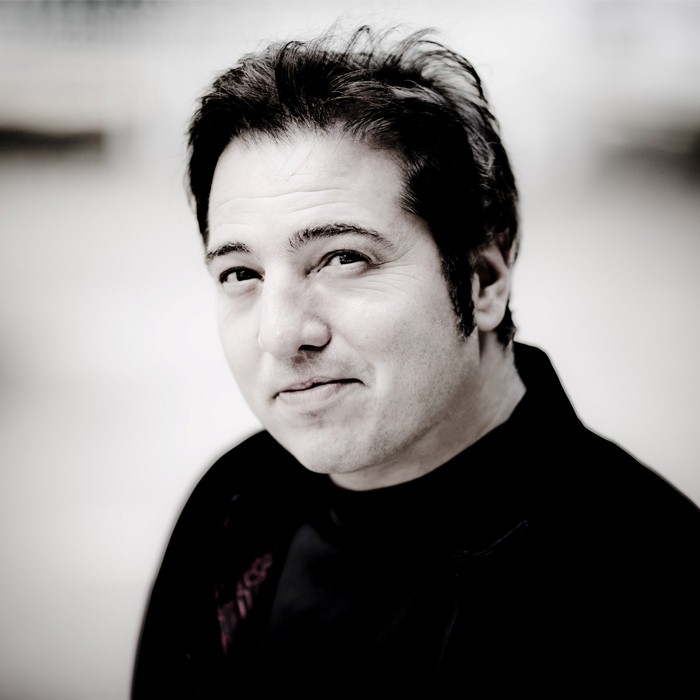Album Releases  view
view
Members
1 Male
Origin
 Turkish
Turkish
Genre
 Pianist
Pianist
Style
Classical
Mood
---
Born
1 Male
Origin
Genre
Style
Classical
Mood
---
Born
1970
Active ---Present...
Cutout![]()
Alternate Name
Fazil Say
1 users
Artist Biography
Available in:
Fazıl Say (born 14 January 1970) is a Turkish pianist and composer who was born in Ankara, described recently as "not merely a pianist of genius; but undoubtedly he will be one of the great artists of the twenty-first century".
Fazıl Say was born in 1970. He was a child prodigy, who was able to do basic arithmetic with 4-digit numbers at the age of two. His father, having found out that he was playing the melody of "Daha Dün Annemizin" (Turkish version of Ah! I will tell you, mom) we have made a move with no prior training, enlisted the help of Ali Kemal Kaya, an oboe artist and a family friend. At the age of three, Say started his piano lessons under the tutelage of pianist Mithat Fenmen.
Say wrote his first piece - a piano sonata - as early as 1984, at the age of fourteen, when he was a student at the Ankara Conservatory of his home town. It was followed, in this early phase of his development, by Schwarze Hymnen for violin and piano and a concerto guitar. He then wrote his first performance in the concert hall, which he had performed in the concert of the Young Concert Artists Auditions in New York: The Four Dances of Nasreddin Hodja. This work already shows in essence the significant features of his personal style: a rhapsodic, fantasia-like basic structure; a variable rhythm, often dance-like, though formed through syncopation; a continuous, vital driving pulse; and a wealth of melodic ideas that may be traced back to folk music themes of Turkey and its neighbors. In these respects, Fazıl Say stands to some extent in the tradition of composers like Bela Bartók, George Enescu, and György Ligeti, who also drew on the rich musical folklore of their countries. He attracted international attention with the piano piece Black Earth (1997), in which he employs techniques familiar to us from John Cage and his works for prepared piano.
After this, Say more to the broad orchestral forms. Názım Hikmet and Metin Altıok, composed for inspiration and the biographies of the writers, chorus and orchestra, especially in the case of the oratorio Nâzim, clearly taking up the tradition of composers such as Orff. In addition to the modern European instrumentarium, the author also makes frequent and deliberate use of these instruments of his native Turkey, including kudüm and darbuka drums and the ney reed flute. This gives the music a color that sets it apart from many comparable creations in this genre. In the year 2007, he wrote a book on the subject of Violin Concerto 1001 Nights in the Harem, which is based on the famous name, but deals specifically with the fate of seven women from a harem. Since its world premiere by Patricia Kopachinskaja, the piece has already received the concert halls.
Fazıl Say scored a further great success with his first symphony, the Istanbul Symphony, premiered in 2010 at the conclusion of his five-year residency at the Konzerthaus Dortmund. Jointly commissioned by the WDR and the Konzerthaus Dortmund in the Ruhr. 2010, the work of the Bosporus and its millions of inhabitants. The same year saw the composition, among other pieces, of his Divorce String Quartet, and commissioned works like the Concerto Nirvana Concerto for the Salzburg Festival and the Trumpet Concerto for the Mecklenburg-Vorpommern Festival, premiered by Gábor Boldoczki.
For Sabine Meyer Saying a clarinet Concerto that refers to the life and work of the Persian poet Omar Khayyam in response to a commission from the 2011 Schleswig-Holstein Musik Festival, and a Sonata for clarinet and piano (op.42) for The Kissinger Sommer Festival in 2012. Fazıl Say's works are published worldwide by Schott Music of Mainz.
In his works Gezi Park 1,2 and 3 (op 48, op.52, op.54) from 2013/14 he musically processed the violent suppression of the protests at the Istanbul Gezi Park.
Wide Thumb
Clearart
Fanart


Banner
User Comments
 No comments yet..
No comments yet..












